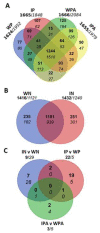The Role of ABA in the Interaction between Citrus Fruit and Penicillium digitatum
- PMID: 36555436
- PMCID: PMC9779756
- DOI: 10.3390/ijms232415796
The Role of ABA in the Interaction between Citrus Fruit and Penicillium digitatum
Abstract
Abscisic acid (ABA) protects citrus fruit against Penicillium digitatum infection. The global mechanisms involved in the role of ABA in the P. digitatum-citrus fruit interaction are unknown. Here, we determine the transcriptome differences between the Navelate (Citrus sinensis (L.) Osbeck) orange and its ABA-deficient mutant Pinalate, which is less resistant to infection. Low ABA levels may affect both the constitutive mechanisms that protect citrus fruit against P. digitatum and early responses to infection. The repression of terpenoid, phenylpropanoid and glutation metabolism; of oxidation-reduction processes; and of processes related to the defense response to fungus and plant hormone signal transduction may be one part of the constitutive defense reduced in the mutant against P. digitatum. Our results also provide potential targets for developing P. digitatum-citrus fruit-resistant varieties. Of those up-regulated by ABA, a thaumatin protein and a bifunctional inhibitor/LTP, which are relevant in plant immunity, were particularly remarkable. It is also worth highlighting chlorophyllase 1 (CLH1), induced by infection in Pinalate, and the OXS3 gene, which was down-regulated by ABA, because the absence of OXS3 activates ABA-responsive genes in plants.
Keywords: abscisic acid (ABA); fungal disease; green mold; postharvest rots; transcriptomic profiling.
Conflict of interest statement
The authors declare no conflict of interest.
Figures



Similar articles
-
Interplay between ABA and phospholipases A(2) and D in the response of citrus fruit to postharvest dehydration.Plant Physiol Biochem. 2013 Sep;70:287-94. doi: 10.1016/j.plaphy.2013.06.002. Epub 2013 Jun 10. Plant Physiol Biochem. 2013. PMID: 23800664
-
Unravelling molecular responses to moderate dehydration in harvested fruit of sweet orange (Citrus sinensis L. Osbeck) using a fruit-specific ABA-deficient mutant.J Exp Bot. 2012 Apr;63(7):2753-67. doi: 10.1093/jxb/err461. Epub 2012 Feb 7. J Exp Bot. 2012. PMID: 22315241 Free PMC article.
-
Characterization of Pinalate, a novel Citrus sinensis mutant with a fruit-specific alteration that results in yellow pigmentation and decreased ABA content.J Exp Bot. 2003 Feb;54(383):727-38. doi: 10.1093/jxb/erg083. J Exp Bot. 2003. PMID: 12554716
-
Penicillium digitatum infection mechanisms in citrus: What do we know so far?Fungal Biol. 2019 Aug;123(8):584-593. doi: 10.1016/j.funbio.2019.05.004. Epub 2019 May 13. Fungal Biol. 2019. PMID: 31345412 Review.
-
Citrus Postharvest Green Mold: Recent Advances in Fungal Pathogenicity and Fruit Resistance.Microorganisms. 2020 Mar 23;8(3):449. doi: 10.3390/microorganisms8030449. Microorganisms. 2020. PMID: 32209982 Free PMC article. Review.
Cited by
-
Genome-wide identification and expression analysis of the MADS gene family in sweet orange (Citrus sinensis) infested with pathogenic bacteria.PeerJ. 2024 Feb 29;12:e17001. doi: 10.7717/peerj.17001. eCollection 2024. PeerJ. 2024. PMID: 38436028 Free PMC article.
References
-
- Palou L., Ali A., Fallik E., Romanazzi G. GRAS, plant- and animal-derived compounds as alternatives to conventional fungicides for the control of postharvest diseases of fresh horticultural produce. Postharvest Biol. Technol. 2016;122:41–52. doi: 10.1016/j.postharvbio.2016.04.017. - DOI
-
- Romanazzi G., Sanzani S.M., Bi Y., Tian S., Gutiérrez Martínez P., Alkan N. Induced resistance to control postharvest decay of fruit and vegetables. Postharvest Biol. Technol. 2016;122:82–94. doi: 10.1016/j.postharvbio.2016.08.003. - DOI
-
- Tian S., Torres R., Ballester A.-R., Li B., Vilanova L., González-Candelas L. Molecular aspects in pathogen-fruit interactions: Virulence and resistance. Postharvest Biol. Technol. 2016;122:11–21. doi: 10.1016/j.postharvbio.2016.04.018. - DOI
MeSH terms
Substances
Supplementary concepts
Grants and funding
LinkOut - more resources
Full Text Sources

